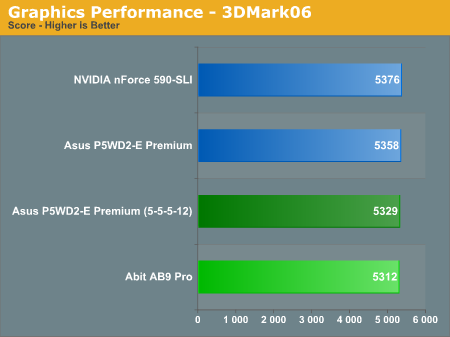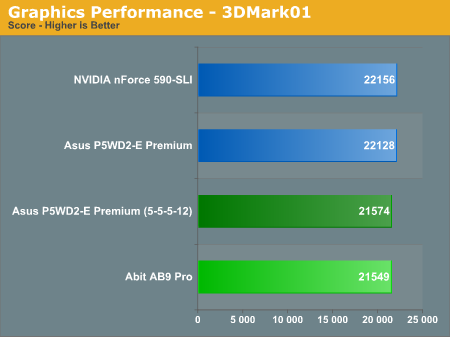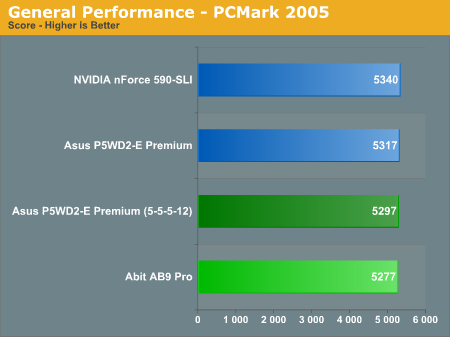Abit AB9 Pro: A sneak peek at Intel's new P965 chipset
by Gary Key on July 3, 2006 3:45 AM EST- Posted in
- Motherboards
Synthetic Graphics Performance
The 3DMark series of benchmarks developed and provided by Futuremark are among the most widely used tools for benchmark reporting and comparisons. Although the benchmarks are very useful for providing apple to apple comparisons across a broad array of GPU and CPU configurations, they are not a substitute for actual application and gaming benchmarks. In this sense we consider the 3DMark benchmarks to be purely synthetic in nature but still valuable for providing consistent measurements of performance.


In our first tests, each platform score is so close that there is no winner here. In the memory and CPU sensitive 3DMark01 benchmark we see the Asus and Abit boards scoring extremely close at the same memory timings. Although we have not reported memory benchmarks scores in this article, the Abit and Asus boards performed almost identically at the same settings indicating the P965 Express chipset will have excellent memory performance.
General System Performance
The PCMark05 benchmark developed and provided by Futuremark was designed for determining overall system performance for the typical home computing user. This tool provides both system and component level benchmarking results utilizing subsets of real world applications or programs. This benchmark is useful for providing comparative results across a broad array of graphics cards, CPUs, hard disks, and memory configurations and it also includes some multithreading results. In this sense we consider the PCMark benchmark to be both synthetic and real world in nature while providing consistency in our benchmark results.

The margins are extremely close in the PCMark05 results but the NVIDIA platform continues to show a very slight advantage over the Intel platform. While looking at the individual test results, we noticed the Abit board matched the other boards in the graphics tests and finished slightly behind in the multitasking tests due to the memory settings. We also noticed the NVIDIA nForce 500 Intel Edition board had 19% better performance than either Intel board in the XP Hard Disk Drive Startup test, with the ICH8R Abit performing 4% better than the ICH7R on the Asus.
The 3DMark series of benchmarks developed and provided by Futuremark are among the most widely used tools for benchmark reporting and comparisons. Although the benchmarks are very useful for providing apple to apple comparisons across a broad array of GPU and CPU configurations, they are not a substitute for actual application and gaming benchmarks. In this sense we consider the 3DMark benchmarks to be purely synthetic in nature but still valuable for providing consistent measurements of performance.


In our first tests, each platform score is so close that there is no winner here. In the memory and CPU sensitive 3DMark01 benchmark we see the Asus and Abit boards scoring extremely close at the same memory timings. Although we have not reported memory benchmarks scores in this article, the Abit and Asus boards performed almost identically at the same settings indicating the P965 Express chipset will have excellent memory performance.
General System Performance
The PCMark05 benchmark developed and provided by Futuremark was designed for determining overall system performance for the typical home computing user. This tool provides both system and component level benchmarking results utilizing subsets of real world applications or programs. This benchmark is useful for providing comparative results across a broad array of graphics cards, CPUs, hard disks, and memory configurations and it also includes some multithreading results. In this sense we consider the PCMark benchmark to be both synthetic and real world in nature while providing consistency in our benchmark results.

The margins are extremely close in the PCMark05 results but the NVIDIA platform continues to show a very slight advantage over the Intel platform. While looking at the individual test results, we noticed the Abit board matched the other boards in the graphics tests and finished slightly behind in the multitasking tests due to the memory settings. We also noticed the NVIDIA nForce 500 Intel Edition board had 19% better performance than either Intel board in the XP Hard Disk Drive Startup test, with the ICH8R Abit performing 4% better than the ICH7R on the Asus.










33 Comments
View All Comments
mechBgon - Thursday, July 6, 2006 - link
Peak. A summit, a maximum value, etc.Peek. A quick look, a glance.
Pique. Annoyance, such as some people experience when "peak" and "peek" get swapped in full view of 2-3 million people. ;)
That is all. We now return you to your regularly-scheduled DailyTech program. :)7
JarredWalton - Saturday, July 8, 2006 - link
It just looked so nice right next to "sneak". We were debating between a "sneek peek", a "sneak peak", and a "snique pique" and you can see which one got the vote. ;)Sorry for the error - proofing thousands of words per week, stuff does slip through occasionally. On the bright side, we can fix the errors as they're caught - revisionist publishing at its best.
zsdersw - Thursday, July 6, 2006 - link
Pique can also mean to provoke or arouse.. as in: "His flashy outfit piqued my interest."commonuser - Thursday, July 6, 2006 - link
good review. particularly so as i've become increasingly interested in the direction these new platforms will take.however, i must say that i'm finding the obsession with SLI/Crossfire a bit overemphasized in every motherboard review i've read on the web as of late. now, i really do not have the exact figures at my disposal, but i'd say with a pretty high level of assumptive confidence that a significantly lower proportion of so-called "enthusiast" cyberpopulace makes use of these solutions, compared to traditional, albeit powerful single-gpu setup (think x1900xtx, or 7900gtx). "mainstream" segment falls into a non-SLI/CF category even more so...
therefore, when we have this opening sentence: , and this sentence in the conclusion: , one has to ask him/herself: what really is the difference among "enthusiast", "mainstream", "value", and/or "entry-level" chipsets and mainboards? is it soon going to be a huge oversight or a mistake if a manufacturer leaves out SLI support on a "value" or "entry-level" MB?
JarredWalton - Saturday, July 8, 2006 - link
Note the criticism is directed at *Intel* for not allowing manufacturers to make 2x8 PCIe configurations using P965. Given the cost of making that change, I would much rather have the option of using SLI/CF even if I never take advantage of it. One PCIe X16 slot is pretty much "value oriented" in my opinion these days.Kiste - Thursday, July 6, 2006 - link
Is it even possible to install WinXP from a PATA drive if the PATA port is 3rd party?I just bought a very nice BenQ PATA DVD writer and I certainly won't get rid of it just to buy Plextor's crappy SATA DVD writer or the even more abysmal one from Samsung.
Gary Key - Thursday, July 6, 2006 - link
Yes, there is limited functionality in the bios that allows the system to recognize the PATA port upon boot and for it to be utilized to load the OS or drivers if the OS is already loaded. We have seen this operation on our first two 965 boards but have one board that would not allow the PATA port to be recognized until the drivers were loaded. We were told this would be corrected in the shipping bios.goinginstyle - Tuesday, July 11, 2006 - link
Is it possible to load Linux with this IDE controller?Kiste - Thursday, July 6, 2006 - link
Ok, I'm not sure I completely understand. I can boot up with my WinXP installation CD and then I'll have to install drivers for the 3rd party PATA controller before I can install WinXP? Is that about right? Does that mean that I need a floppy drive?JarredWalton - Saturday, July 8, 2006 - link
If the BIOS is designed correctly, it can make the base XP installation detect the 3rd party IDE without drivers. Some earlier IDE chipsets didn't work (back in nF3 and ealier time frame), but most IDE and SATA solutions will now work without a driver disk. You would still need the driver disk for RAID, and certain BIOS settings might require it as well.